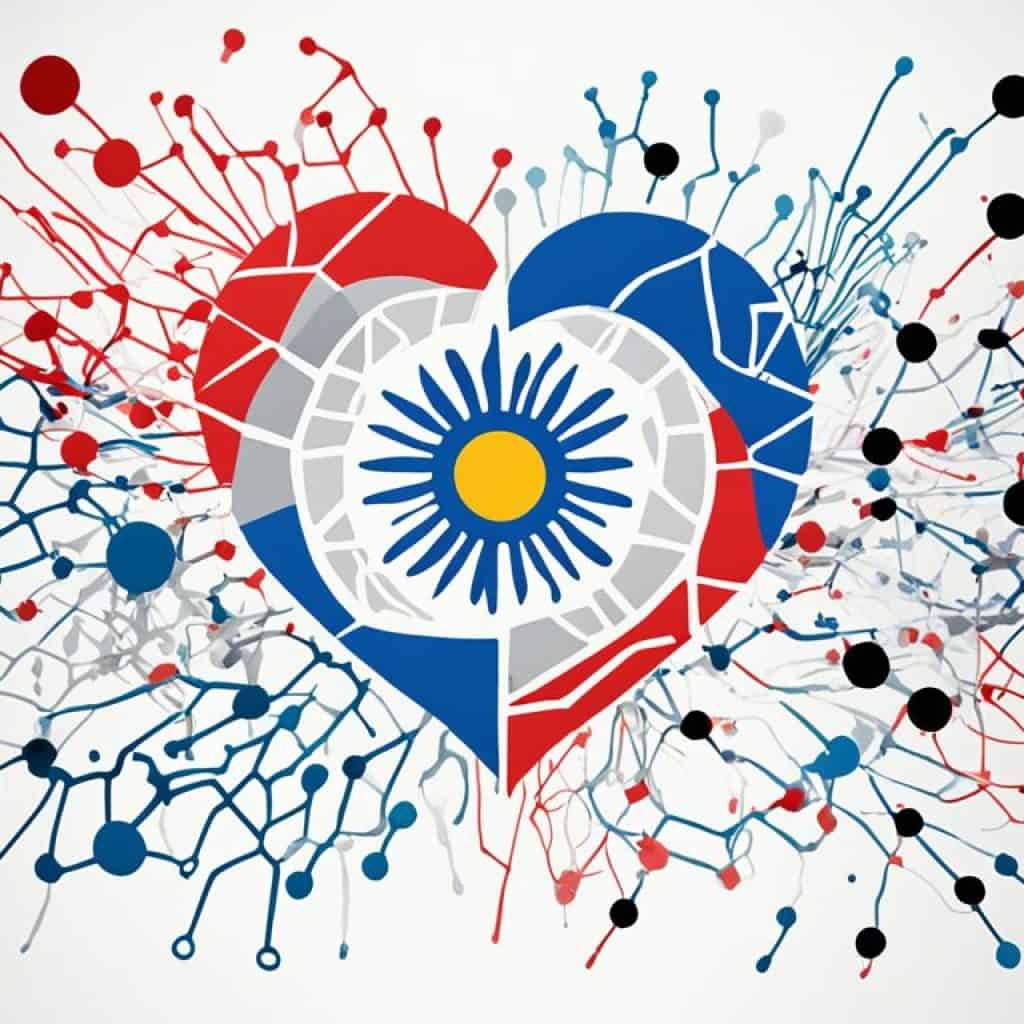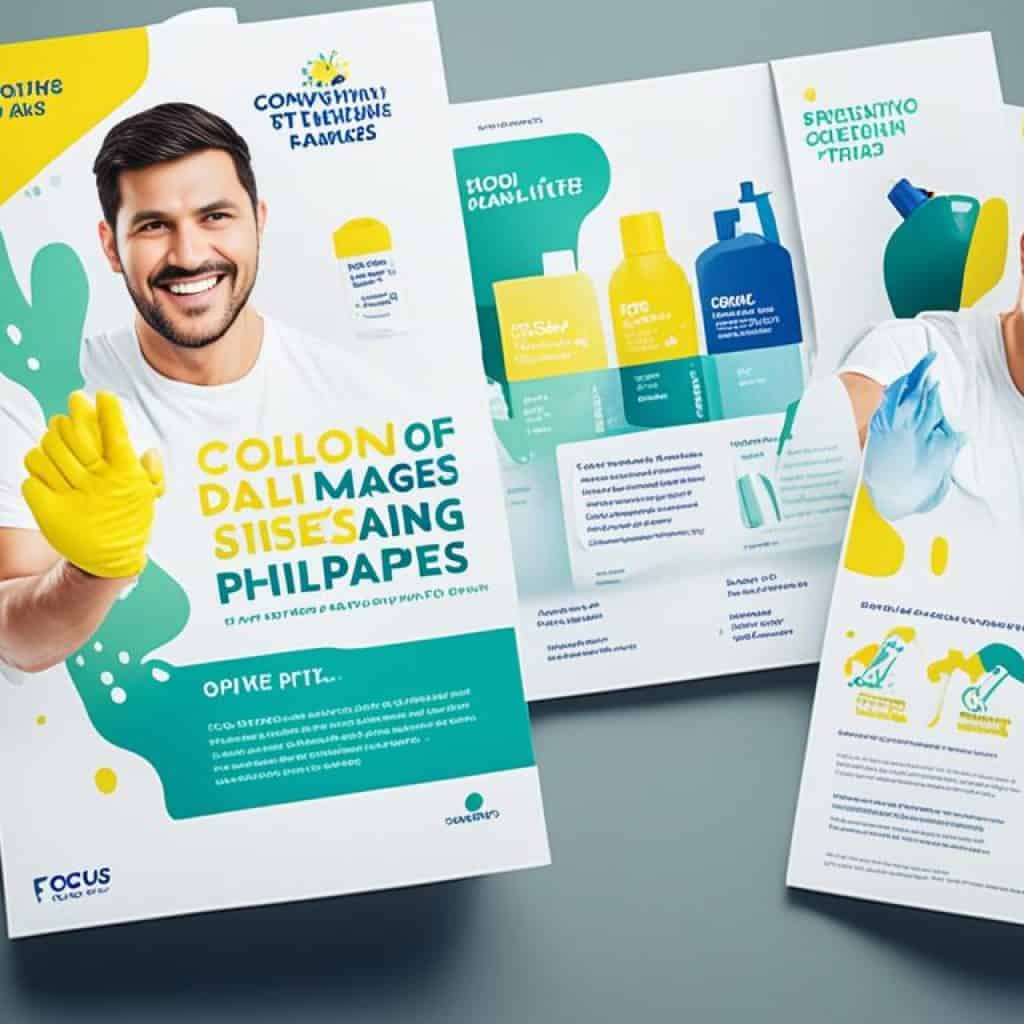When traveling to the Philippines, ensuring your health and well-being is a top priority. While the country offers stunning landscapes and vibrant experiences, it’s essential to be aware of the prevalent health conditions you may encounter during your visit. From infectious diseases to food and water safety, understanding how to stay healthy can make all the difference in your journey.
So, what are the common diseases in the Philippines that travelers should be aware of? Are there any preventive measures you can take to minimize your risk? Let’s explore the factors that can affect your health and discover the key steps to safeguard yourself against potential health hazards during your trip.
Key Takeaways:
- Stay updated on current health advisories and make sure you are aware of the prevalent diseases in the Philippines.
- Take necessary precautions to protect yourself from COVID-19 and other infectious diseases.
- Practice good hygiene and follow food and water safety guidelines to avoid foodborne illnesses.
- Protect yourself from bug bites by using insect repellent and taking preventive measures.
- Be mindful of safety when engaging in outdoor activities and encountering animals in the Philippines.
COVID-19 in the Philippines
The COVID-19 pandemic has had a significant impact on the Philippines since the first case was confirmed in January 2020. To address the challenges posed by this infectious disease, the Centers for Disease Control and Prevention (CDC) has been actively involved in providing support and assistance to the country’s COVID-19 vaccination program implementation.
The CDC has not only extended technical expertise but also offered financial support to bolster the vaccination efforts in the Philippines. Collaborating closely with the Department of Health (DOH) and other partners, CDC continues to play a crucial role in facilitating COVID-19 vaccination planning and execution.
Recognizing the importance of surveillance in tracking the SARS-CoV-2 variants, CDC and its partners are developing comprehensive plans to leverage the interests and investments of the U.S. Government and the Government of the Philippines. This collaboration aims to strengthen variant surveillance capabilities and enhance response strategies accordingly.
Furthermore, in partnership with the World Health Organization (WHO), CDC is actively engaged in conducting surveillance for adverse events associated with immunization. This cooperative effort ensures that any potential side effects or complications related to COVID-19 vaccination are closely monitored and addressed.
| Key Contributions | COVID-19 Vaccination Support |
|---|---|
| Technical expertise | Financial assistance |
| Collaboration with DOH and partners | SARS-CoV-2 variant surveillance development |
| Partnership with WHO | Surveillance for adverse events associated with immunization |
Ensuring Public Health and Safety
The concerted efforts of CDC, together with its local and international partners, are instrumental in mitigating the impact of COVID-19 in the Philippines. Through vaccination support, surveillance programs, and collaborative initiatives, the aim is to safeguard public health and enable the country to effectively respond to the challenges posed by infectious diseases.
Mortality rate in the Philippines
The mortality rate in the Philippines is a significant indicator of the health status and well-being of its population. Understanding the distribution of causes of death can provide valuable insights into prevalent health conditions and potential areas for improvement.
One interactive platform that allows for a comprehensive analysis of the mortality rate in the Philippines is the WHO Mortality Database. This database compiles mortality data from various sources and presents it in a user-friendly format, making it easy to explore and extract meaningful information.
By examining the mortality rate data, researchers and policymakers can identify trends, patterns, and disparities in health outcomes. This information can then be used to develop targeted interventions and allocate resources effectively to address the country’s most pressing health issues.
Furthermore, the WHO Mortality Database’s visualization tools enable users to delve deeper into specific causes of death. This granular analysis can help identify the diseases and conditions that contribute most significantly to the mortality rate in the Philippines.
| Leading Causes of Death in the Philippines | Mortality Rate |
|---|---|
| Cardiovascular diseases | XXX per 100,000 population |
| Cancer | XXX per 100,000 population |
| Respiratory diseases | XXX per 100,000 population |
This table provides a snapshot of the leading causes of death in the Philippines and their corresponding mortality rates. It is essential to note that these figures are approximate and may vary over time. However, they serve as a starting point for understanding the health landscape of the country.
By analyzing the mortality rate in the Philippines and gaining insights into prevalent health conditions, stakeholders can make informed decisions and implement targeted interventions to improve the well-being of the population. Through collaborative efforts and evidence-based strategies, progress can be made in addressing the country’s health challenges and reducing premature mortality.
Evolving Priorities for Health Promotion
As data on the mortality rate continues to shape our understanding of health in the Philippines, it is crucial to recognize that health priorities evolve over time. New diseases emerge, lifestyle factors change, and advancements in healthcare influence patterns of mortality.
“The mortality rate in the Philippines serves as a crucial barometer for evaluating the effectiveness of healthcare interventions and guiding future efforts in disease prevention and health promotion.” – Dr. Maria Santos, Director of Philippine Institute of Public Health
Continual monitoring of the mortality rate is essential to identify emerging health challenges and track progress in addressing existing ones. As the data collection and analysis methods improve, our understanding of prevalent health conditions and their impact on mortality rates will become more nuanced, enabling targeted and effective public health strategies.

This powerful image provides a visual representation of the mortality rate in the Philippines, capturing the magnitude of the challenge and the need for concerted efforts to improve health outcomes. It serves as a reminder of the importance of ongoing research, collaboration, and innovation to safeguard the well-being of the Filipino population.
Food and Water Safety in the Philippines
When traveling to the Philippines, it is crucial to prioritize food and water safety. Standards can vary both within the country and based on different destinations. To ensure your well-being, it is essential to make informed choices about what you eat and drink.
| Safe Food and Drink Choices | Water Treatment Options | Global Water, Sanitation, and Hygiene |
|---|---|---|
|
|
|
“Safe food and drink choices are essential for a healthy trip to the Philippines. By following these guidelines, you can lower the risk of foodborne illnesses and gastrointestinal problems.”
For more information on safe food and drink options, water treatment methods, and global water, sanitation, and hygiene practices, you can consult reliable resources such as travel health websites, government advisories, or speak with a healthcare professional.
Bug Bite Prevention in the Philippines
Bugs, such as mosquitoes, ticks, and fleas, can spread diseases in the Philippines. Many of these diseases cannot be prevented with vaccines or medicines. It is crucial to take proactive measures to reduce the risk of bug bites and protect yourself from potential health hazards.
Cover Exposed Skin
One effective way to prevent bug bites is to cover exposed skin. Wear long-sleeved shirts, long pants, and closed-toe shoes to minimize the skin’s exposure to bugs. This physical barrier creates a protective layer against insect bites.
Use Insect Repellent
Applying insect repellents can provide an additional layer of defense against bug bites. Choose an EPA-registered insect repellent that contains active ingredients such as DEET, picaridin, or oil of lemon eucalyptus (OLE). Follow the instructions on the product label for proper and safe usage.
Stay and Sleep in Protected Areas
When staying in accommodations, prioritize air-conditioned or screened rooms to minimize the entry of bugs. These controlled environments provide a safer space to rest and sleep without the risk of bug bites. Bed nets can also be used for added protection, especially in areas where mosquitoes are prevalent.
Common Bug-Borne Diseases in the Philippines
| Disease | Vector | Prevention |
|---|---|---|
| Dengue fever | Mosquitoes | Sleep under bed nets, remove stagnant water, use mosquito repellent |
| Malaria | Mosquitoes | Take antimalarial medication, sleep under bed nets, use mosquito repellent |
| Lyme disease | Ticks | Wear protective clothing, use tick repellent, conduct tick checks after outdoor activities |
By following these bug bite prevention measures, you can significantly reduce the risk of contracting diseases spread by bugs in the Philippines. Stay vigilant and prioritize your health and well-being during your time in the country.
Outdoor Safety in the Philippines
If you’re planning to indulge in outdoor activities in the picturesque Philippines, it’s essential to prioritize your safety and well-being. By taking the necessary precautions, you can enjoy your adventures to the fullest without compromising your health. Here are some key tips to help you stay safe and protected:
1. Stay Alert to Changing Weather Conditions
Before embarking on any outdoor activity, carefully monitor weather forecasts and be prepared for unpredictable changes. Sudden storms or extreme heat can pose risks, so it’s crucial to stay informed and have a plan in case of emergencies.
2. Wear Appropriate Clothing and Protective Gear
Dress appropriately for the outdoor activity you’re engaging in. Wear comfortable, lightweight clothing that provides adequate protection against the elements. Don’t forget to wear sturdy footwear, sun hats, and sunglasses to shield yourself from the sun’s harmful rays.
3. Learn Basic First Aid
Equipping yourself with basic first aid knowledge can make a significant difference in emergency situations. Take the time to learn essential first aid techniques like CPR, treating minor injuries, and recognizing symptoms of heat exhaustion or dehydration.
4. Stay Hydrated in Hot Temperatures
The tropical climate of the Philippines can be unforgiving, especially during hot summer months. Make sure to drink plenty of water to stay hydrated and prevent heat-related illnesses. Carry a reusable water bottle and refill it regularly to ensure you have access to clean drinking water.
5. Protect Yourself from UV Radiation
The sun’s rays can be intense, even on overcast days. Apply sunscreen with a high SPF rating and wear protective clothing to prevent sunburns and long-term skin damage. Seeking shade whenever possible and wearing a wide-brimmed hat can also provide extra protection.
6. Be Cautious Around Water and Animals
Whether you’re swimming in crystal-clear waters or exploring lush forests, it’s vital to respect the natural environment and wildlife. Always be cautious around bodies of water, especially if you’re not an experienced swimmer. Avoid touching or disturbing animals, as some can be dangerous or carry diseases.
“Safety should always be at the forefront of your mind when engaging in outdoor activities. By following these guidelines, you can stay secure and make the most of your adventures in the beautiful Philippines.”
Remember, taking precautions and being mindful of your surroundings can significantly contribute to a safe and enjoyable outdoor experience in the Philippines.
| Essential Outdoor Safety Tips |
|---|
| Stay alert to changing weather conditions |
| Wear appropriate clothing and protective gear |
| Learn basic first aid techniques |
| Stay hydrated in hot temperatures |
| Protect yourself from UV radiation |
| Be cautious around water and animals |
Animal Safety in the Philippines
In the beautiful landscapes of the Philippines, it’s important to be mindful of the wildlife that you may encounter. While most animals will steer clear of humans, it’s crucial to exercise caution to avoid any potential animal bites or scratches. These incidents can lead to serious diseases, including the dreaded rabies. By following a few recommendations, you can ensure your safety and enjoy your time in the Philippines without any unwanted encounters.
Guidelines for Animal Safety
- Do not touch or feed unknown animals: It’s best to maintain a safe distance from unfamiliar animals, as their behavior can be unpredictable. Respect their space and observe them from a distance.
- Avoid contact with rodent urine and feces: Rodents can carry diseases such as leptospirosis. Be cautious when visiting areas where rodent activity is prevalent, and avoid any contact with their waste.
- Seek immediate medical care if bitten or scratched: In the unfortunate event of an animal bite or scratch, it’s crucial to seek medical attention without delay. Prompt medical care can help prevent potential complications.
Remember, prevention is key when it comes to animal safety. By being aware of your surroundings and following these guidelines, you can minimize the risk of animal-related incidents and enjoy a safe and memorable experience in the Philippines.

“Respect for all living creatures is the cornerstone of advancing animal welfare.” – Carl P. Safina
Germ Prevention in the Philippines
To avoid getting sick or spreading illness in the Philippines, it is crucial to practice good hygiene. By following these simple steps, you can protect yourself and others from harmful germs:
- Frequent Handwashing: Washing your hands with soap and water for at least 20 seconds is one of the most effective ways to prevent the spread of germs. Remember to wash your hands before eating, after using the restroom, and whenever they are dirty.
- Hand Sanitizer: When soap and water are not available, use an alcohol-based hand sanitizer that contains at least 60% alcohol. Apply it to the palm of one hand and rub your hands together until dry.
- No Face Touching: Avoid touching your face, especially your eyes, nose, and mouth. Germs can enter your body through these openings and cause infection.
- Cover Your Mouth and Nose: When coughing or sneezing, use a tissue or your elbow to cover your mouth and nose. Dispose of used tissues properly and wash your hands immediately afterwards.
- Avoid Sick Individuals: Minimize close contact with people who are sick, as they can easily spread germs. Keep a safe distance and encourage them to seek medical attention if needed.
- Stay Home if Feeling Unwell: If you are experiencing symptoms such as fever, cough, or sore throat, it is important to stay home and avoid close contact with others. Resting and seeking medical advice can help prevent the further spread of illness.
By incorporating these germ prevention practices into your daily routine, you can take proactive steps to protect your health and the well-being of those around you.
“Prevention is always better than cure. By practicing good hygiene, you can significantly reduce your risk of getting sick or spreading illness.”
| Germ Prevention Tips | Benefits |
|---|---|
| Frequent handwashing | Removes germs and prevents their transmission |
| Using hand sanitizer | Kills germs on the go when soap and water are unavailable |
| Avoiding face touching | Reduces the risk of germs entering your body through mucous membranes |
| Covering mouth and nose | Prevents the spread of respiratory droplets containing germs |
| Avoiding contact with sick individuals | Minimizes exposure to contagious diseases |
| Staying home if feeling unwell | Helps contain the spread of illness within the community |
Avoiding Sharing Body Fluids in the Philippines
Diseases can be spread through body fluids, such as saliva, blood, vomit, and semen. To protect yourself and prevent the transmission of diseases, it is important to follow these guidelines:
- Use latex condoms correctly: When engaging in sexual activity, always use latex condoms correctly and consistently to reduce the risk of sexually transmitted infections.
- Avoid injecting drugs: Sharing needles or other drug paraphernalia can transmit diseases, including HIV and hepatitis. Avoid injecting drugs altogether to protect your health.
- Limit alcohol consumption: Excessive alcohol consumption can impair judgment and increase the likelihood of engaging in risky behaviors, including unsafe sexual practices. Drink responsibly to minimize the risk of disease transmission.
- Avoid sharing needles or devices: If you require medical procedures involving needles or devices that break the skin, ensure they are single-use and properly disposed of. Sharing these items can lead to the transmission of bloodborne diseases.
- Ensure medical and dental equipment is properly disinfected: When seeking healthcare in the Philippines, ensure that medical and dental equipment used during procedures is properly sterilized. This helps to prevent the spread of infections.
By following these practices, you can reduce the risk of disease transmission through body fluids and protect your health while in the Philippines.

Accessing Medical Care in the Philippines
When planning a trip to the Philippines, it’s important to consider your medical care options and make appropriate arrangements. Here are some essential steps to ensure you can access healthcare during your visit:
Research Local Doctors and Hospitals
Before your trip, take the time to compile a list of local doctors and hospitals in the areas you will be visiting. This preparation will help you in case you require medical attention while in the Philippines.
Review Your Health Insurance Coverage
Ensure that your health insurance coverage extends to international travel. Review your policy and familiarize yourself with the benefits and limitations of your plan. Consider purchasing travel health insurance for additional coverage, if necessary.
Carry Necessary Medical Information and Prescriptions
It’s important to carry your medical information and any prescriptions you may need during your trip. This includes information about your existing medical conditions, allergies, and medications. Having this information readily available will help healthcare providers in case of emergency or routine care.
Be Aware of Medicine Availability
Understand that the availability of certain medicines may vary in the Philippines. Some medications may require special authorization or may not be available at all. Check in advance to ensure you have an ample supply of any necessary medications for the duration of your trip.
Consider Medical Evacuation Insurance
In the event of a medical emergency, having medical evacuation insurance can provide peace of mind. This type of insurance covers the cost of transporting you to a suitable medical facility if local care is inadequate or inaccessible.
Be Knowledgeable About Malaria Risk Areas
The Philippines has regions with a risk of malaria. If you plan to visit these areas, take necessary precautions such as taking antimalarial medication, using mosquito nets, and applying insect repellent. Consult with a healthcare professional before your trip for guidance on malaria prevention.
By following these steps, you can ensure that you are well-prepared to access medical care during your trip to the Philippines. Your health and well-being should always be a priority, and taking the necessary precautions will help you have a safe and enjoyable travel experience.
Safe Transportation in the Philippines
Motor vehicle crashes are a leading cause of death for travelers in foreign countries. When visiting the Philippines, it is crucial to prioritize safe transportation to ensure a secure and enjoyable trip. By following a few essential guidelines, you can minimize the risks associated with motor vehicle accidents and enhance your overall safety.
Here are some key tips for safe transportation in the Philippines:
- Choose safe transportation options: Opt for reputable transportation services such as licensed taxis or reputable ride-hailing platforms for commuting within cities. These services prioritize passenger safety and adhere to traffic regulations.
- Follow traffic rules: Familiarize yourself with the local traffic laws and regulations. Observe speed limits, traffic signals, and road signs to minimize the risk of accidents.
- Wear seatbelts: Always fasten your seatbelt when traveling in a vehicle. It is important for both drivers and passengers to buckle up, as wearing seatbelts significantly reduces the likelihood of severe injuries during accidents.
- Avoid overcrowded vehicles or motorcycles: While it may be common to see overcrowded public transportation, it is advisable to prioritize your safety. Steer clear of vehicles that are packed beyond their intended capacity to reduce the risk of accidents.
- Be cautious when walking: Practice pedestrian safety by using crosswalks, pedestrian bridges, and sidewalks whenever possible. Stay alert and watch out for vehicles, especially in busy urban areas.
- Avoid alcohol before driving: Consuming alcohol impairs judgment and reaction time, significantly increasing the risk of accidents. It is crucial to refrain from drinking and driving to safeguard yourself and others on the road.
- Consider hiring a licensed and knowledgeable driver: If you are not familiar with local driving conditions, hiring a licensed driver who knows the area well can provide an added layer of safety. They can navigate the roads and traffic while ensuring compliance with local laws.
By adhering to these safe transportation practices, you can effectively minimize the risks associated with motor vehicle accidents in the Philippines. Prioritizing your safety will contribute to a memorable and worry-free travel experience.
Example Quote:
“Safe transportation is the cornerstone of a successful trip. By being mindful of traffic rules, choosing reliable transportation options, and prioritizing seatbelt usage, travelers can significantly reduce the risk of accidents and enjoy a safe journey through the picturesque Philippines.” – Travel Safety Expert
Motor Vehicle Safety Statistics in the Philippines
| Year | Number of Road Traffic Deaths |
|---|---|
| 2016 | 10,012 |
| 2017 | 9,322 |
| 2018 | 8,672 |
| 2019 | 8,693 |
| 2020 | 6,614 |
These statistics highlight the importance of prioritizing safe transportation practices in the Philippines. While efforts have been made to reduce road traffic fatalities, it is crucial for travelers to be cautious and responsible while on the road.
Summary
Safe transportation is a critical aspect of travel safety in the Philippines. By following traffic rules, choosing reliable transportation options, wearing seatbelts, and being cautious when walking, travelers can significantly reduce the risk of motor vehicle accidents. Prioritizing safety ensures a smooth and enjoyable journey through the beautiful landscapes of the Philippines.
Conclusion
In conclusion, when traveling to the Philippines, it is important to be aware of the common diseases that may pose a risk to your health. Among these diseases, COVID-19 is of particular concern. However, by taking the necessary precautions and following safety measures, you can minimize the risk of contracting these diseases and ensure a safe and enjoyable trip.
One key aspect of staying healthy in the Philippines is to adhere to food and water safety guidelines. It is important to choose safe food and drink options, especially when traveling to different destinations within the country. Additionally, preventing bug bites is crucial as mosquitoes, ticks, and fleas can transmit diseases. By covering exposed skin, using insect repellent, and staying in air-conditioned or screened rooms, you can reduce the risk of bug-borne illnesses.
Outdoor safety is another important consideration. Whether engaging in adventurous activities or simply exploring the beautiful landscapes of the Philippines, it is vital to stay alert to changing weather conditions, wear appropriate clothing and protective gear, and practice basic first aid. Additionally, exercising caution when encountering animals can help prevent injuries and diseases such as rabies.
To maintain good health and prevent the spread of illness, practicing good hygiene is essential. This includes frequent handwashing, covering your mouth and nose when coughing or sneezing, avoiding contact with sick individuals, and staying home if you feel unwell. Avoiding sharing body fluids and ensuring medical care access, as well as safe transportation, are also crucial factors to consider for a healthy trip to the Philippines.


















Add comment